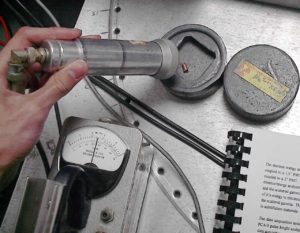
Beta dosimetry is very specific, because beta particles are more penetrating than alpha particles. On the other hand a thin aluminum plate can stop them.
Alpha and beta particles, in general, constitute no external exposure hazard because the particles generally do not pass through skin. On the other hand, alpha and beta radiation is very harmful, when their radionuclides are ingested or inhaled. Internal exposure is more dangerous than external exposure, since we are carrying the source of radiation inside our bodies and we cannot use any of radiation protection principles (time, distance, shielding).
Studies have shown that alpha and neutron radiation cause greater biological damage for a given energy deposition per kg of tissue than gamma radiation does. It was discovered, biological effects of any radiation increases with the linear energy transfer (LET). In short, the biological damage from high-LET radiation (alpha particles, protons or neutrons) is much greater than that from low-LET radiation (gamma rays). This is because the living tissue can more easily repair damage from radiation that is spread over a large area than that which is concentrated in a small area. Because more biological damage is caused for the same physical dose (i.e., the same energy deposited per unit mass of tissue), one gray of alpha or neutron radiation is more harmful than one gray of gamma radiation. This fact that radiations of different types (and energies) give different biological effects for the same absorbed dose is described in terms of factors known as the relative biological effectiveness (RBE) and the radiation weighting factor (wR).
Radiation Weighting Factors – ICRP
For photon and electron radiation, the radiation weighting factor has the value 1 independently of the energy of the radiation and for alpha radiation the value 20. For neutron radiation, the value is energy-dependent and amounts to 5 to 20.
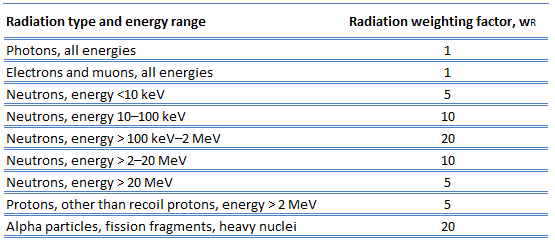
In 2007 ICRP published a new set of radiation weighting factors(ICRP Publ. 103: The 2007 Recommendations of the International Commission on Radiological Protection). These factors are given below.
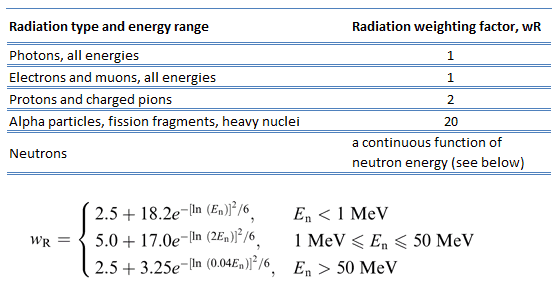
As shown in the table, a wR of 1 is for all low-LET radiations, i.e. X-rays and gamma rays of all energies as well as electrons and muons. A smooth curve, considered an approximation, was fitted to the wRvalues as a function of incident neutron energy. Note that En is the neutron energy in MeV.
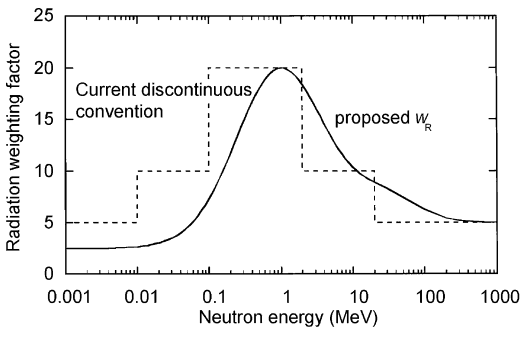
Thus for example, an absorbed dose of 1 Gy by alpha particles will lead to an equivalent dose of 20 Sv, and an equivalent dose of radiation is estimated to have the same biological effect as an equal amount of absorbed dose of gamma rays, which is given a weighting factor of 1.
Detectors of Beta Radiation
Detectors may be also categorized according to sensitive materials and methods that can be utilized to make a measurement:
Detection of Beta Radiation using Ionization Chamber
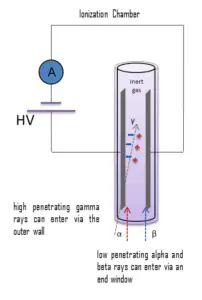 For alpha and beta particles to be detected by ionization chambers, they must be provided with a thin window. This “end-window” must be thin enough for the alpha and beta particles to penetrate. However, a window of almost any thickness will prevent an alpha particle from entering the chamber. The window is usually made of mica with a density of about 1.5 – 2.0 mg/cm2.
For alpha and beta particles to be detected by ionization chambers, they must be provided with a thin window. This “end-window” must be thin enough for the alpha and beta particles to penetrate. However, a window of almost any thickness will prevent an alpha particle from entering the chamber. The window is usually made of mica with a density of about 1.5 – 2.0 mg/cm2.
Ionization chamber may be, for example, used for the measurement of tritium in the air. These devices are known as tritium-in-air monitors. Tritium is a radioactive isotope, but it emits a very weak form of radiation, a low-energy beta particle that is similar to an electron. It is a pure beta emitter (i.e. beta emitter without an accompanying gamma radiation). The electron’s kinetic energy varies, with an average of 5.7 keV, while the remaining energy is carried off by the nearly undetectable electron antineutrino. Such a very low energy of electron causes, that the electron cannot penetrate the skin or even does not travel very far in air. Beta particles from tritium can penetrate only about 6.0 mm of air. It is practically impossible to design a detector whose walls these beta particles can penetrate. Instead, tritium-in-air monitor pumps the tritium-contaminated air right through an ionization chamber, so that all of the energy of the beta particles can be usefully converted to producing ion pairs inside the chamber.
Detection of Beta Radiation using Scintillation Counter
Scintillation counters are used to measure radiation in a variety of applications including hand held radiation survey meters, personnel and environmental monitoring for radioactive contamination, medical imaging, radiometric assay, nuclear security and nuclear plant safety. They are widely used because they can be made inexpensively yet with good efficiency, and can measure both the intensity and the energy of incident radiation.
Scintillation counters can be used to detect alpha, beta, gamma radiation. They can be used also for detection of neutrons. For these purposes, different scintillators are used.
- Beta Particles. For detection of beta particles, organic scintillators can be used. Pure organic crystals include crystals of anthracene, stilbene and naphthalene. The decay time of this type of phosphor is approximately 10 nanoseconds. This type of crystal is frequently used in the detection of beta particles. Organic scintillators, having a lower Z than inorganic crystals, are best suited for the detection of low-energy (< 10 MeV) beta particles.
Detection of Beta Radiation using Semiconductors – Silicon Strip Detectors
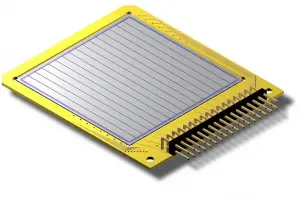
Silicon-based detectors are very good for tracking charged particles. A silicon strip detector is an arrangement of strip like shaped implants acting as charge collecting electrodes.
Silicon strip detectors 5 x 5 cm2 in area are quite common and are used in series (just like planes of MWPCs) to determine charged-particle trajectories to position-accuracies of the order of several μm in the transverse direction. Placed on a low doped fully depleted silicon wafer these implants form a one-dimensional array of diodes. By connecting each of the metalized strips to a charge sensitive amplifier a position sensitive detector is built. Two dimensional position measurements can be achieved by applying an additional strip like doping on the wafer backside by use of a double sided technology. Such devices can be used to measure small impact parameters and thereby determine whether some charged particle originated from a primary collision or was the decay product of a primary particle that traveled a small distance from the original interaction, and then decayed.
Portable Survey Meters
Portable survey meters are radiation detectors used by radiological technicians to measure ambient dose rate. These portable instruments usually have rate meters. In nuclear facilities, these portable survey meters are typically used by radiation protection technicians, which are responsible for following operations in the field to help assure that radiation protection policies are carried out and that jobs are implemented in accordance with the ALARA principle. Their responsibilities include:
- Providing assistance and advice to workers to motivate them to adopt an ALARA behaviour.
- Following jobs to ensure the respect of safety and radiation protection procedures.
- In some plants, stopping work in case of serious deviation from dosimetric objectives, or when there is a significantly increasing radiological risk for workers.
The typical radiation survey meter is, for example, the RDS-31, which is a multi-purpose radiation survey meter that uses a G-M detector. It has optional alpha, beta, and gamma external probes. It measures 3.9 x 2.6 x 1.3 inches and can be handheld, or worn by pocket, belt clip, or pouch. It has a five-digit, backlit, LCD display. Geiger counters operate at such a high voltage that the size of the output pulse is always the same, regardless of how many ion pairs were created in the detector. Geiger counters are mainly used for portable instrumentation due to its sensitivity, simple counting circuit, and ability to detect low-level radiation.
Film Badge Dosimeter
Film badge dosimeters are for one-time use only, they cannot be reused. A film badge dosimeter is dosimeter, that is worn at the surface of the body by the person being monitored, and it records of the radiation dose received. The film badge is used to measure and record radiation exposure due to gamma rays, X-rays and beta particles. The badge incorporates a series of filters (lead, tin, cadmium and plastic) to determine the quality of the radiation. To monitor beta particle emission, the filters use various densities of plastic or even label material. It is typical for a single badge to contain a series of filters of different thicknesses and of different materials; the precise choice may be determined by the environment to be monitored.
Examples of filters:
- There is an open window that makes it possible for weaker radiations to reach the film.
- A thin plastic filter which attenuates beta radiation but passes all other radiations
- A thick plastic filter which passes all but the lowest energy photon radiation and absorbs all but the highest beta radiation.
- A dural filter which progressively absorbs photon radiation at energies below 65 keV as well as beta radiation.
- A tin/lead filter of a thickness which allows an energy independent dose response of the film over the photon energy range 75 keV to 2 MeV.
- A cadmium lead filter can be used for thermal neutrons detection. The capture of neutrons ((n,gamma) reactions) by cadmiumproduces gamma rays which blacken the film thus enabling assessment of exposure to neutrons.
We hope, this article, Beta Dosimetry – Beta Dosimeter, helps you. If so, give us a like in the sidebar. Main purpose of this website is to help the public to learn some interesting and important information about radiation and dosimeters.